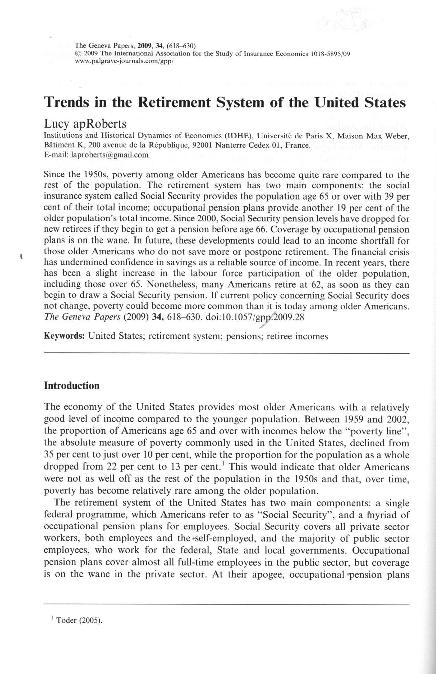Trends in the retirement system of the United States

Contenido multimedia no disponible por derechos de autor o por acceso restringido. Contacte con la institución para más información.
| Tag | 1 | 2 | Valor |
|---|---|---|---|
| LDR | 00000cab a2200000 4500 | ||
| 001 | MAP20090093690 | ||
| 003 | MAP | ||
| 005 | 20100223125323.0 | ||
| 008 | 091027e20091001esp|| p |0|||b|spa d | ||
| 040 | $aMAP$bspa$dMAP | ||
| 084 | $a40 | ||
| 100 | $0MAPA20090036970$aRoberts, Lucy | ||
| 245 | 0 | 0 | $aTrends in the retirement system of the United States$cLucy Roberts |
| 520 | $aSince the 1950s, poverty among the older Americans has become quite rare compared to the rest of the population. The retirement system has two main components: the social insurance system called Social Secuirty provides the population age 65 or over with 39 per cent of their total income; occupational pension plans provide another 19 per cent of the older population's total income. Since 2000, Social Security pension levels have dropped for new retirees if they begin to get a pension before age 66. Coverage by occupational pension plans is on the wane. In future, these developments could lead to an income shortfall for those older Americans who do not save more or pospone retirement. The financial crisis has undermined confidence in savings as a reliable source of income. In recent years, there has been a slight increase in the labour fore participation of the older population, including those over 65. Nonetheless, many Americans retire at 62, as soon as they can begin to draw a Social Security pension. If currente policy concerning Social Security does not change, poverty could become more common than it is today among older Americans. | ||
| 650 | 1 | $0MAPA20080604004$aSistemas de pensiones | |
| 650 | 1 | $0MAPA20080624682$aPlanes de pensiones asociados | |
| 650 | 1 | $0MAPA20080578107$aSeguridad Social | |
| 650 | 1 | $0MAPA20080554927$aJubilación | |
| 650 | 1 | $0MAPA20080584825$aEdad de jubilación | |
| 650 | 1 | $0MAPA20080587369$aReforma financiera | |
| 651 | 1 | $0MAPA20080638337$aEstados Unidos | |
| 773 | 0 | $wMAP20077100215$tGeneva papers on risk and insurance : issues and practice$dGeneva : The Geneva Association, 1976-$x1018-5895$g01/10/2009 Tomo 34 Número 4 - 2009 , p. 618-630 |

